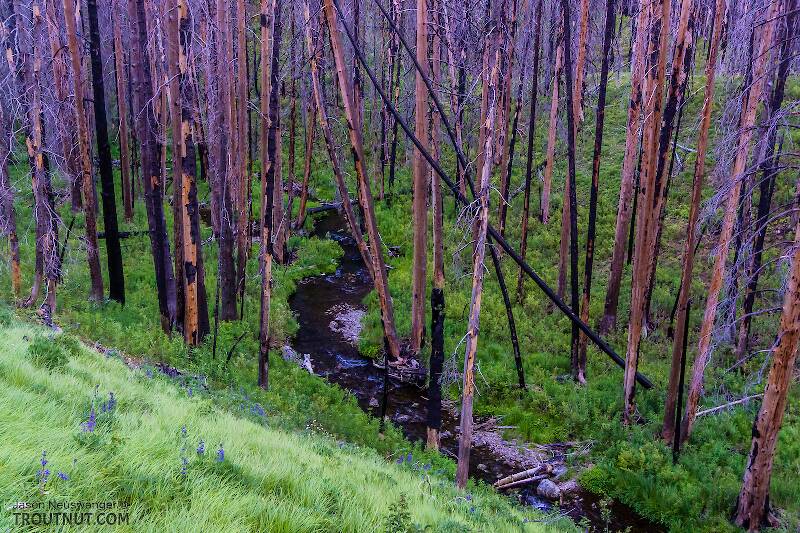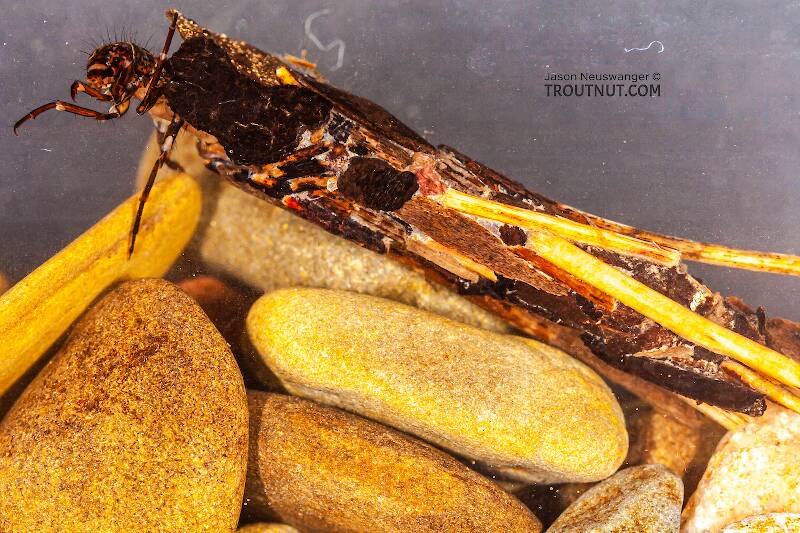
Blue-winged Olives
Baetis
Tiny Baetis mayflies are perhaps the most commonly encountered and imitated by anglers on all American trout streams due to their great abundance, widespread distribution, and trout-friendly emergence habits.
Featured on the forum

Troutnut is a project started in 2003 by salmonid ecologist Jason "Troutnut" Neuswanger to help anglers and
fly tyers unabashedly embrace the entomological side of the sport. Learn more about Troutnut or
support the project for an enhanced experience here.
This topic is about the Caddisfly Genus Pycnopsyche
Example specimens
BrettB on Oct 2, 2008October 2nd, 2008, 7:16 am EDT
Came in to work today and noted several large Autumn sedges on doors facing river(18mm wing-to-head and 34mm total w/ antennae). Though more brownish-rusty than I remember them being, I'm relatively certain it is a Pycnopsyche due to the size, timing and dark markings near the rear mid-wing (sort of looks like a yin-yang symbol). Does anyone know of a good emerger fly for this hatch? I'm assuming it emerges in the evening through early morning. I may tie up some size 8 rusty elk hair caddis for adult imitations. Big bugs!
Brett Billings
long-time tyer and amateur entomologist
long-time tyer and amateur entomologist
GONZO on Oct 2, 2008October 2nd, 2008, 7:54 am EDT
Brett,
Although some might emerge on the surface, most Pycnopsyche crawl out to emerge. A surface emerger is usually not of much value. A large fur-bodied soft hackle crawled along the bottom toward shore can be effective for imitating the pupae. In addition to the dry adult pattern, a big rusty wet could also be useful when the adults are laying eggs.
Although some might emerge on the surface, most Pycnopsyche crawl out to emerge. A surface emerger is usually not of much value. A large fur-bodied soft hackle crawled along the bottom toward shore can be effective for imitating the pupae. In addition to the dry adult pattern, a big rusty wet could also be useful when the adults are laying eggs.
BrettB on Oct 3, 2008October 3rd, 2008, 9:35 am EDT
Gonzo,
Thanks for the ideas. I like the idea of a big, fat wet fly on the bottom late in the afternoon as nymphs start to drift. A big wet fly in size 10 or 12? Perhaps some grey-brown muskrat fur with partridge hackle? Sounds like a very promising technique. The rusty wet fly also sounds good.
Thanks for the ideas. I like the idea of a big, fat wet fly on the bottom late in the afternoon as nymphs start to drift. A big wet fly in size 10 or 12? Perhaps some grey-brown muskrat fur with partridge hackle? Sounds like a very promising technique. The rusty wet fly also sounds good.
Brett Billings
long-time tyer and amateur entomologist
long-time tyer and amateur entomologist
GONZO on Oct 3, 2008October 3rd, 2008, 9:49 am EDT
I'd go lighter with the body color on the pupa, Brett. The belly is usually a pale creamy color with a ginger tint and the back is a darker ginger-brown. A loose mix of those colors will suffice for a general suggestion. You might want to dub a band of blackish brown just behind the soft-hackle collar to suggest the dark wingpads. A #10-12 (2X) should be about right.
Quick Reply
Related Discussions
Topic
Replies
Last Reply
6
Mar 9, 2019
by Steverz
by Steverz
3
Jan 16, 2007
by Martinlf
by Martinlf
Re: Identification of a possible Cordulegaster Dragonfly Nymph
In Cordulegaster Dragonfly Nymph by IanB
In Cordulegaster Dragonfly Nymph by IanB
6
Feb 10, 2017
by Taxon
by Taxon






